Все способы:
- Способ 1: Средство автоматического устранения неполадок
- Способ 2: Проверка состояния службы
- Способ 3: Ручная установка обновлений
- Способ 4: Восстановление системных файлов
- Способ 5: Установка/включение .NET Framework
- Решение возможных проблем
- Способ 6: Редактирование реестра
- Вопросы и ответы: 2
Способ 1: Средство автоматического устранения неполадок
Если ошибка 0x800f0831 возникает при попытке обновить систему Windows 10, стоит попробовать устранить возможные проблемы, которые могут быть связаны непосредственно с «Центром обновления». В операционке уже предустановлено средство для этого, вам останется только запустить его вручную:
- Откройте меню «Пуск» и запустите приложение «Параметры».
- Перейдите в раздел «Обновление и безопасность» в открывшемся окне.
- На панели слева переключитесь на вкладку «Устранение неполадок», затем в центральной части окна щелкните по ссылке «Дополнительные средства устранения неполадок».
- В списке доступных средств найдите строку «Центр обновления Windows» и щелкните по ней. Появится кнопка, запускающая средство, на которую нужно нажать.
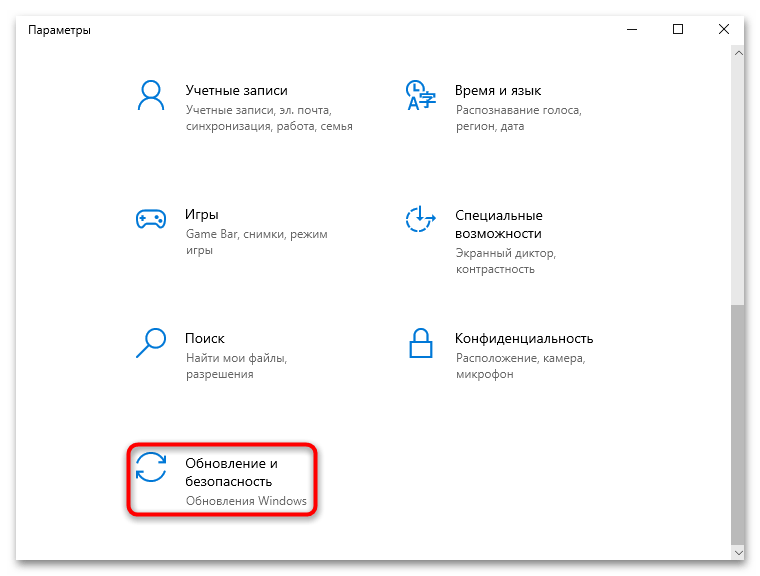
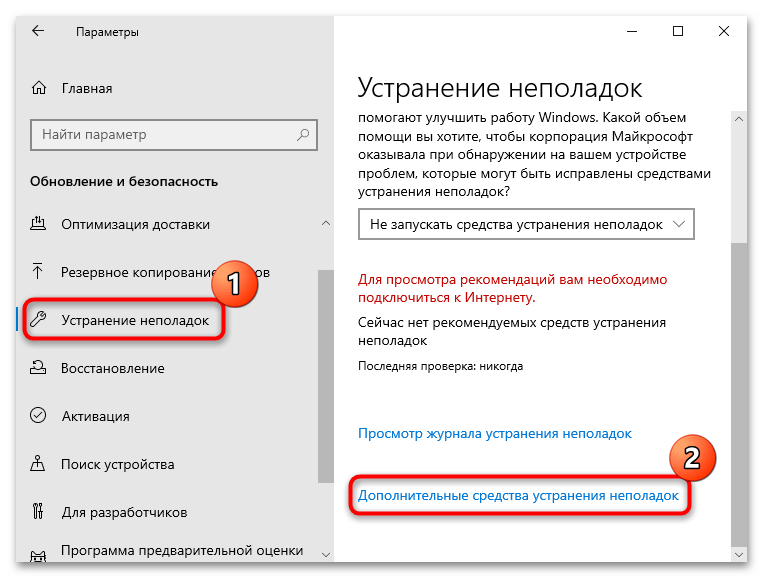
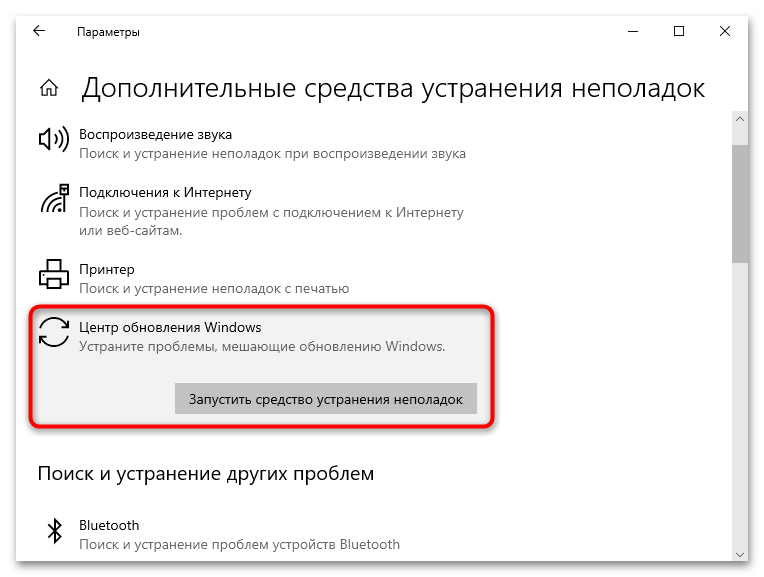
Процесс автоматизирован: средство начнет сканирование системы на наличие неполадок, которые могли стать причиной проблем в работе «Центра обновления Windows», тем самым вызывая ошибку. Если понадобится вмешательство со стороны пользователя, будут предложена инструкция по исправлению ситуации.
Способ 2: Проверка состояния службы
Также стоит проверить, включена ли служба «Центра обновления Windows». Она должна работать и иметь автоматический тип запуска для корректной загрузки и установки обновлений в систему.
- Вызовите диалоговое окно «Выполнить», используя сочетание клавиш «Win + R», затем введите запрос
services.mscи нажмите на кнопку «ОК» для открытия оснастки по управлению службами. - В списке найдите пункт «Центр обновления Windows» и дважды кликните по нему левой кнопкой мыши.
- В следующем окне убедитесь, что установлен автоматический тип запуска. Если нет, выставьте его из выпадающего меню и примените настройки.
- Если потребуется, запустите работу службы, нажав на соответствующую кнопку, затем подтвердите новые параметры кнопкой «ОК».
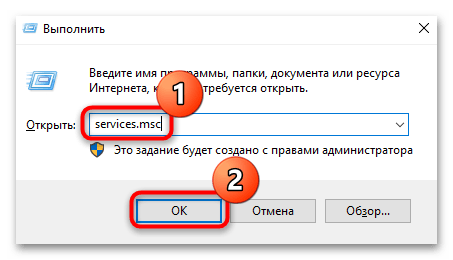
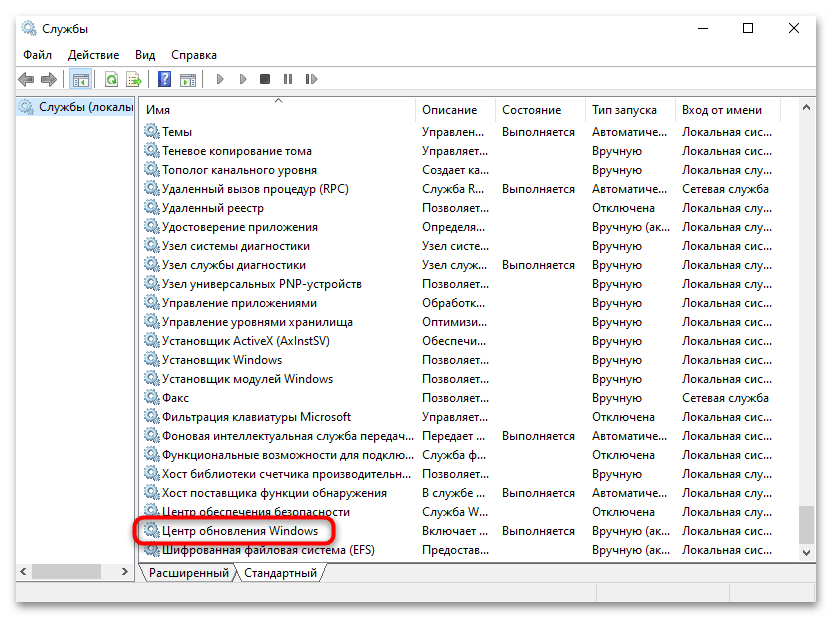

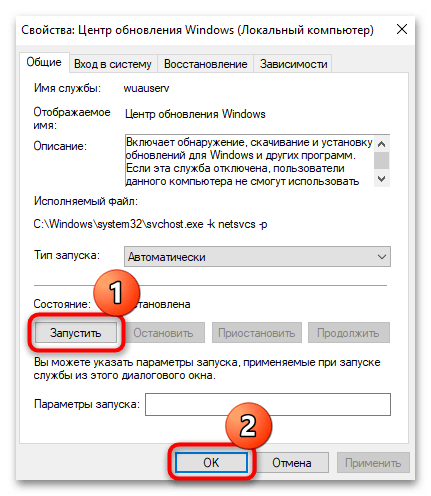
После можно закрывать оснастку «Службы» и проверять, устранена ли ошибка 0x800f0831 в Windows 10.
Способ 3: Ручная установка обновлений
Некоторые обновления не могут быть установлены в систему автоматически ввиду самых разных обстоятельств. Тогда следует попробовать произвести эту процедуру вручную. В некоторых случаях это позволяет исправить текущую ошибку и избавиться от появления новых аналогичных неполадок. Для этого понадобится зайти на официальный сайт Microsoft, самостоятельно скачать нужный апдейт и инициализировать его установку. Детальнее про такой метод обновления ОС узнайте из нашего отдельного материала.
Подробнее: Устанавливаем обновления для Windows 10 вручную
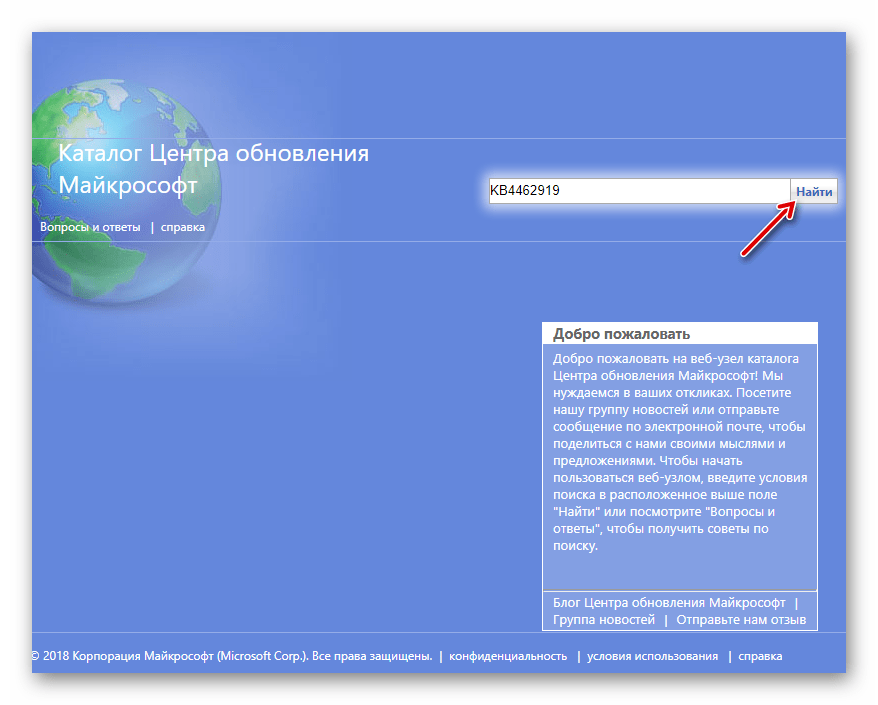
Способ 4: Восстановление системных файлов
Как ни странно, но одна из самых распространенных ошибок порой оказывается связана с повреждением системных файлов. Вам потребуется проверить их целостность и восстановить при необходимости, а для этого в Windows 10 уже есть встроенная утилита SFC. Ранее мы разбирали, как правильно ее применять. Также можно дополнительно воспользоваться средством DISM для сканирования и восстановления целостности хранилища системных файлов.
Подробнее: Как проверить целостность системных файлов в Windows 10
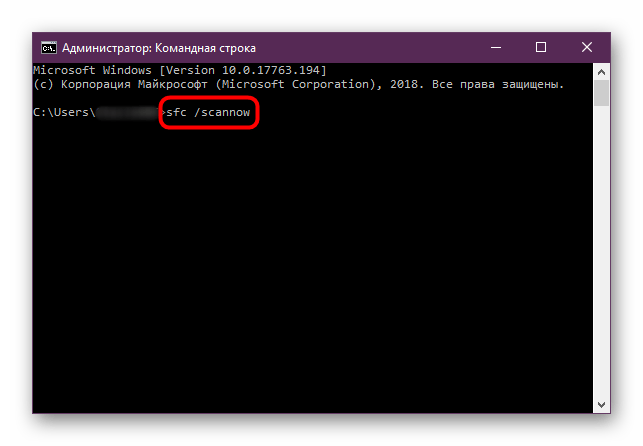
Способ 5: Установка/включение .NET Framework
Компоненты .NET Framework нужны для корректного запуска программного обеспечения, некоторых веб-служб и даже обновлений в Windows 10. Поскольку чаще всего ошибка 0x800f0831 связана с апдейтами, стоит активировать .NET Framework или при необходимости установить (если не удается включить более ранние версии):
- Запустите классическую «Панель управления», отыскав средство в главном меню или с помощью строки поиска.
- Для удобства в меню «Просмотр» измените просмотра на «Крупные значки» или «Мелкие значки», затем откройте раздел «Программы и компоненты».
- В новом окне кликните по строке «Включение и выключение компонентов Windows», расположенной на панели слева.
- В списке найдите пункты, где есть название «.NET Framework», отметьте их и нажмите на кнопку «ОК».
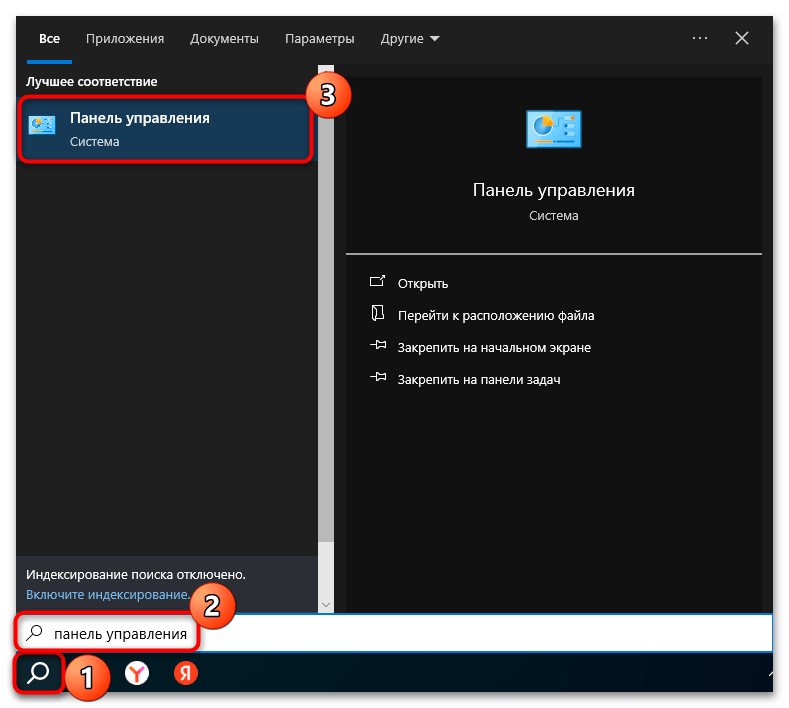
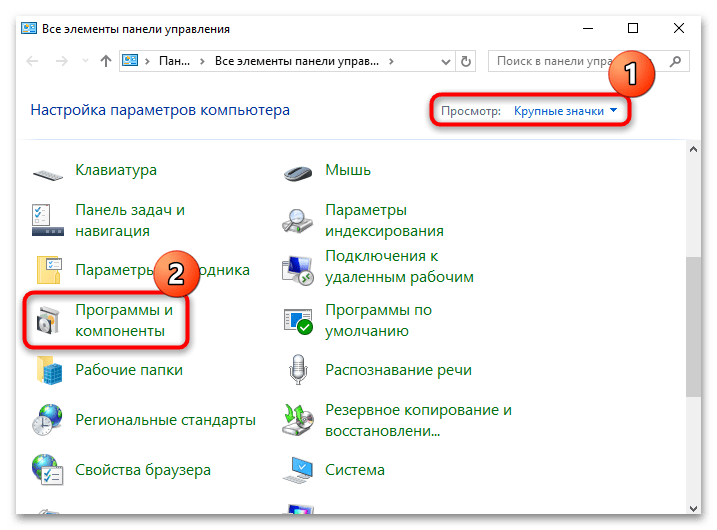
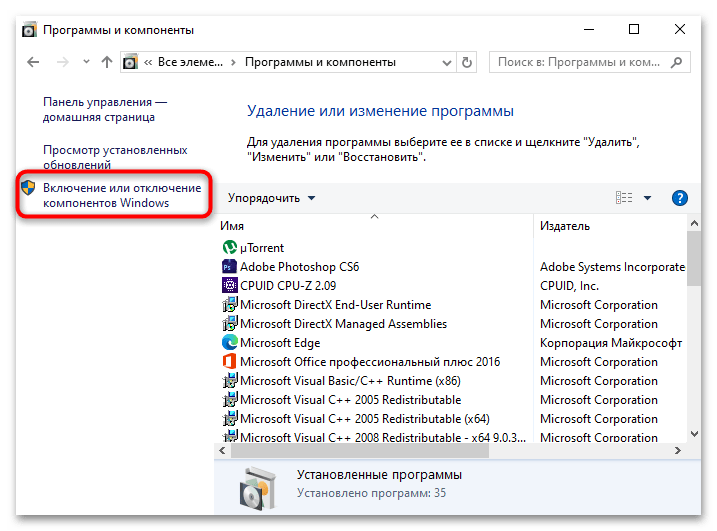
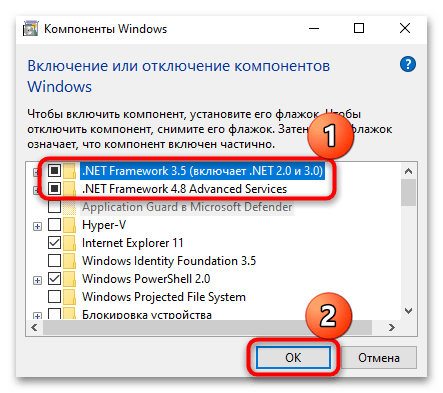
Перезагрузите компьютер и проверьте, была ли устранена неполадка.
Решение возможных проблем
Встречаются ситуации, когда более ранняя версия компонента попросту не запускается или не устанавливается. Ее можно активировать принудительно, создав исполняемый файл, но предварительно понадобится создать установочный накопитель (оптический диск или флешку):
- Создайте загрузочный накопитель с образом Windows 10 так, как описано в нашем отдельном руководстве.
Подробнее: Руководство по созданию загрузочной флешки / диска с Windows 10
- Подключите флешку (или вставьте диск в привод, если это накопитель такого типа), затем запустите «Этот компьютер» и посмотрите, какая буква присвоена загрузочному накопителю. Далее запустите «Командную строку» от имени администратора: в поисковой строке ОС введите запрос
cmdи выберите нужный тип запуска. - Вставьте команду
Dism /online /enable-feature /featurename:NetFX3 /All /Source:X:sourcessxs /LimitAccess, где под буквой «X» подразумевается буква вашего загрузочного накопителя.
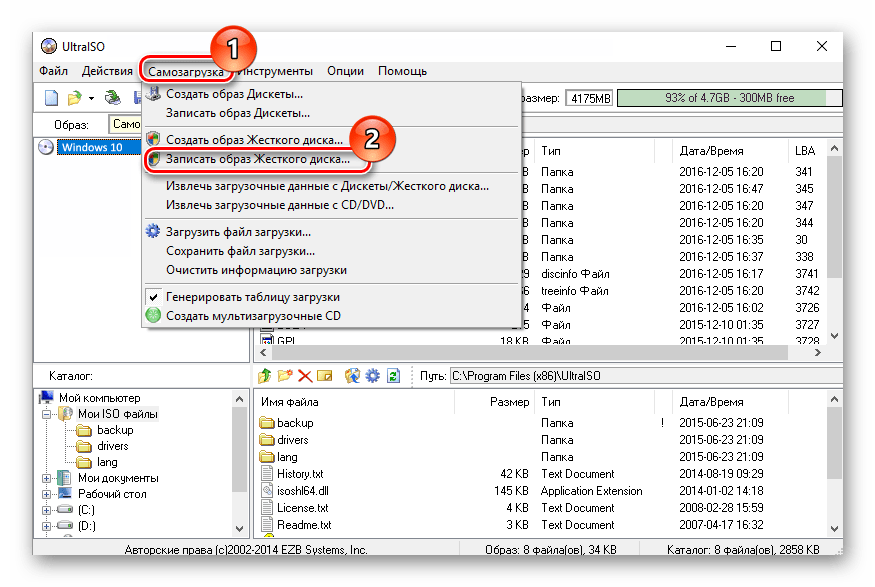
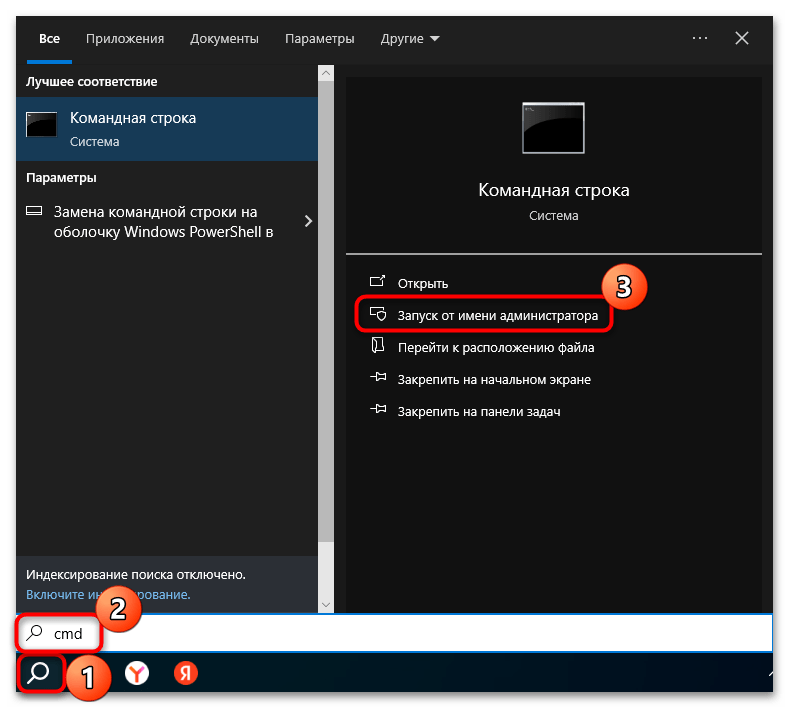
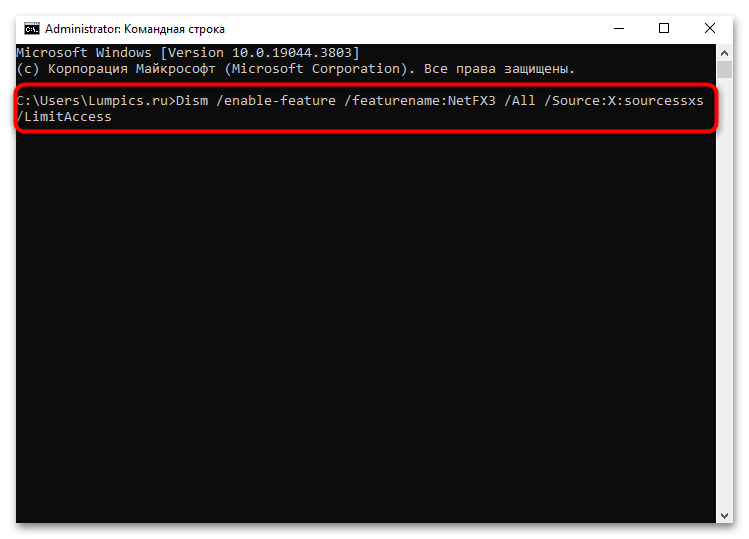
Теперь запустите офлайн-установщик .NET Framework с помощью специального скрипта. В некоторых случаях это значительно может сэкономить время (если такую процедуру потребуется проделывать не единожды). Отметим, что установочный накопитель все равно необходим.
- Откройте штатный «Блокнот» и вставьте в документ следующее содержание:
Title .NET Framework 3.5 Offline Installer
for %%I in (D E F G H I J K L M N O P Q R S T U V W X Y Z) do if exist "%%I:sourcesinstall.wim" set setupdrv=%%I
if defined setupdrv (
echo Found drive %setupdrv%
echo Installing .NET Framework 3.5...
Dism /online /enable-feature /featurename:NetFX3 /All /Source:%setupdrv%:sourcessxs /LimitAccess
echo.
echo .NET Framework 3.5 should be installed
echo.
) else (
echo No installation media found!
echo Insert DVD or USB flash drive and run this file once again.
echo.
)
Pause - Нажмите на вкладку «Файл» и выберите «Сохранить как».
- Выберите из меню «Тип файла» пункт «Все файлы» и задайте имя для будущего скрипта, дописав в конце расширение исполняемого файла —
.exe, затем укажите место для сохранения.
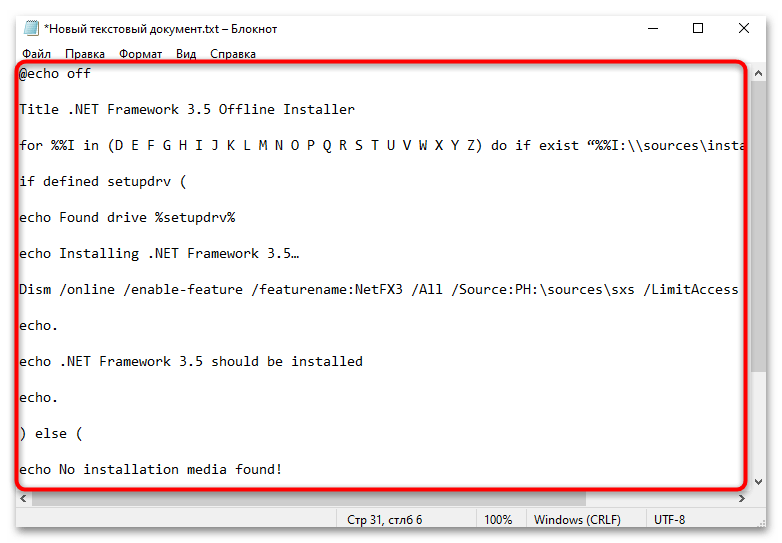
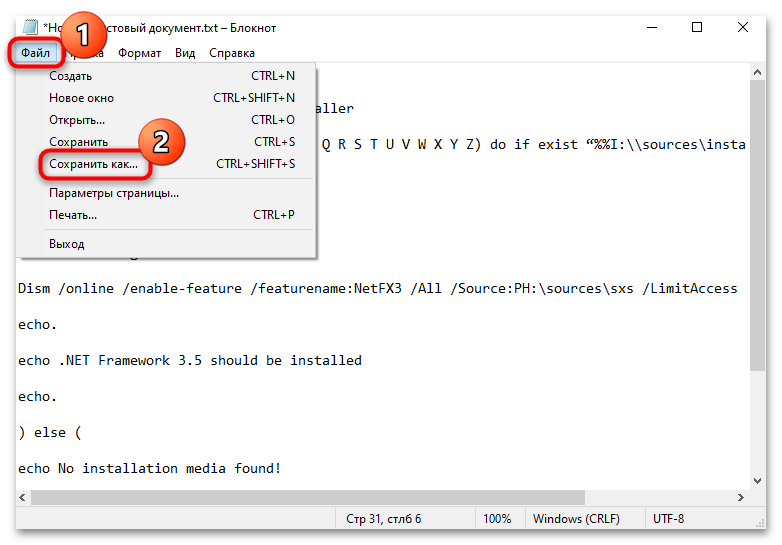

На этом создание скрипта завершено. После подключения к компьютеру установочного накопителя и двойного клика по созданному файлу начнется установка устаревшего компонента .NET Framework в офлайн-режиме.
Иногда может потребоваться переустановка компонентов .NET Framework, несмотря на то, что они уже предустановлены в системе. Такое оказывается необходимо, если они по каким-то причинам были повреждены (тогда и включить их в соответствии с инструкцией выше вряд ли получится). О переустановке ПО мы писали в тематической статье на сайте.
Подробнее: Переустановка .NET Framework в Windows 10
Способ 6: Редактирование реестра
Если ничего не помогло, есть вариант очистить системный реестр от разделов, которые содержат в себе ключи обновления Windows 10. После их удаления система создаст новые автоматически, и таким образом получится исправить некоторые ошибки.
- Через окно «Выполнить» (сочетание клавиш «Win + R») запустите «Редактор реестра», введя команду
regeditи нажав на кнопку «ОК». - Разверните ветку
HKEY_LOCAL_MACHINE\SOFTWARE\Policies\Microsoft\Windows\или вставьте путь в адресную строку вверху. - На панели слева в каталоге «Windows» отыщите разделы под названием «WUServer» и «WIStatusServer» — их понадобится удалить. Кликайте поочередно по каждой папке правой кнопкой мыши, выбирайте пункт «Удалить», после чего подтверждайте действие.
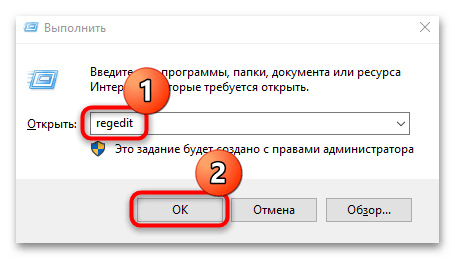
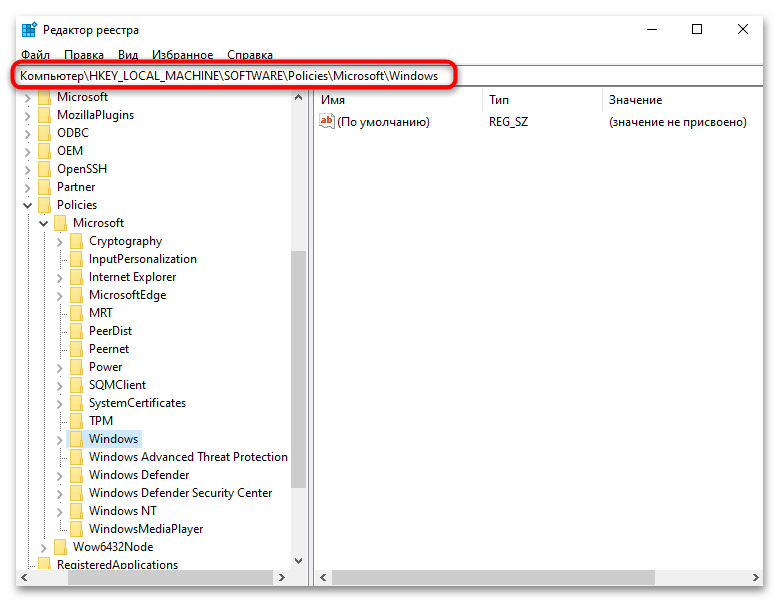
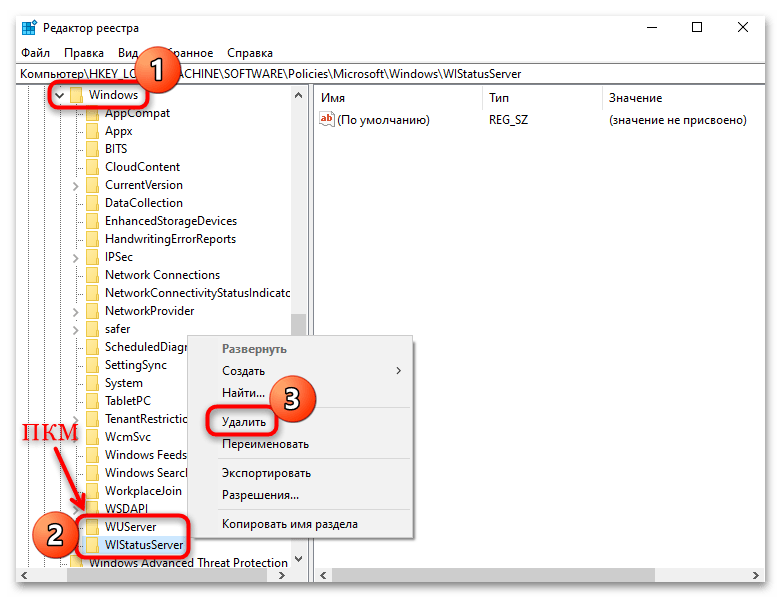
Чтобы система создала новые разделы в системном реестре, перезагрузите компьютер и попробуйте снова обновить Windows 10.
Наша группа в TelegramПолезные советы и помощь
Ошибка 0x800f0831, как правило, обнаруживается пользователями в системном средстве «Просмотр событий» после неудачной установки кумулятивного обновления для ОС Windows.
Причины ошибки 0x800f0831
Самая распространенная на сегодняшний день причина за 0x800f0831 — это отсутствующий манифест предыдущего пакета обновлений. Другими словами, Центр обновлений Windows не может понять, какой конкретно апдейт был установлен ранее, а поэтому он отказывается производить установку нового. Решается все ручной установкой нужного обновления.
К другим причинам можно отнести:
- не удается установить подключение с серверами Центра обновления Windows;
- отключена служба Центра обновления;
- в системе отсутствуют библиотеки .NET 3.5 Framework.
Как исправить ошибку 0x800f0831
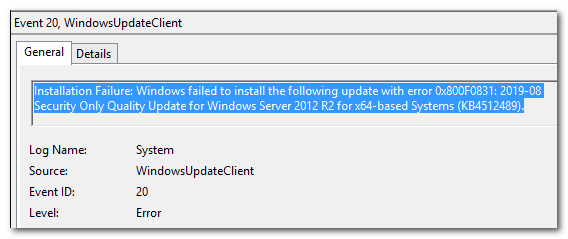
Метод №1 Установка нужного обновления вручную
Самый простой метод решения подобной ошибки — установка проблемного обновления вручную. Откройте журнал обновлений в Центре обновления и узнайте номер апдейта, с которым у вашей системы возникает ошибка 0x800f0831.
Например, пользователи частенько жалуются на эту ошибку с обновлением под номером KB4512489. Так или иначе как только вы узнаете номер, перейдите по этой ссылке и найдите нужное обновление. Далее вам остается загрузить пакет обновления и запустить установку.
Метод №2 Отключение VPN или прокси
Тут все довольно просто: отключите VPN или прокси-сервер, если вы используете их у себя на компьютере. Дело в том, что данные средства могут буквально блокировать подключение к серверам Центра обновления, что делает апдейт ОС Windows невозможным.
Вот как отключить прокси-сервер на своем компьютере:
- нажмите Win+S для вызова поисковой строки;
- пропишите «прокси» и выберите «Параметры прокси-сервера»;
- отключите прокси-сервер, выставив «Откл.» возле соответствующей опции;
- перезагрузите свой компьютер.
VPN от сторонних разработчиков вам придется отключать самостоятельно. Как только VPN и прокси-сервер будут деактивированы, попробуйте обновить свою Windows еще раз. На этот раз ошибки 0x800f0831 может не быть.
Метод №3 Корректировка параметров службы Центра обновления
Возможно, служба Центра обновления перестала по той или иной причине работать в вашей системе. Например, некоторое ПО может деактивировать определенные службы в ОС Windows. Вам необходимо открыть свойства службы и выставить для нее нужные параметры. Попробуйте сделать вот что:
- нажмите Win+R;
- пропишите services.msc и нажмите Enter;
- найдите службу «Центр обновления Windows» и дважды кликните на нее ЛКМ;
- выберите в типе запуска значение «Автоматически»;
- сохраните изменения и перезагрузите ПК.
Запустите обновление Windows и проверьте наличие ошибки 0x800f0831.
Метод №4 SFC и DISM
Системные файлы и хранилище компонентов Windows могли повредиться. Вам нужно пустить в работу средства SFC и DISM, дабы восстановить их. Сделать это можно вот так:
- нажмите Windows+R;
- напишите cmd и нажмите Ctrl+Shift+Enter;
- выполните следующий ряд команд, перезагружая свой ПК после каждой из них:
- sfc / scannow
- dism /online /cleanup-image /restorehealth
Метод №5 Включение .NET Framework 3.5
Ошибка 0x800f0831 при обновлении Windows может возникать в том случае, если в вашей системе деактивирован .NET Framework 3.5. Для его активации вам нужно сделать следующее:
- нажмите Win+R и выполните appwiz.cpl;
- кликните на ссылку «Включение и отключение компонентов Windows»;
- активируйте .NET Framework 3.5 и сохраните изменения;
- перезагрузите компьютер.
Если у вас не получилось включить .NET Framework 3.5 вышеуказанным способом, то попробуйте сделать следующее:
- создайте установочный носитель Windows;
- нажмите Win+R;
- пропишите notepad.exe и нажмите Ctrl+Shift+Enter;
- вставьте в Блокнот этот набор команд:
- @echo off
Title .NET Framework 3.5 Offline Installer
for %%I in (D E F G H I J K L M N O P Q R S T U V W X Y Z) do if exist «%%I:\\sources\install.wim» set setupdrv=%%I
if defined setupdrv (
echo Found drive %setupdrv%
echo Installing .NET Framework 3.5…
Dism /online /enable-feature /featurename:NetFX3 /All /Source:PLACEHOLDER:\sources\sxs /LimitAccess
echo.
echo .NET Framework 3.5 should be installed
echo.
) else (
echo No installation media found!
echo Insert DVD or USB flash drive and run this file once again.
echo.
)
pause
- @echo off
Заметка: замените PLACEHOLDER на букву, которой подписан установочный носитель Windows.
- сохраните файл в любое удобное вам место и (обязательно!) измените его расширение на .cmd;
- дважды кликните на созданный файл и дождитесь завершения процесс активации .NET Framework 3.5;
- перезагрузите компьютер.
Запускаем обновление Windows и смотрим, возникнет ли снова ошибка 0x800f0831.
When you’re trying to install a new Windows cumulative update, error code 0x800f0831 may sometimes pop up on the screen. This error indicates your computer could not access Microsoft’s Update servers or the update services stopped working. Restart your computer and check if the error persists. If it does, follow the steps below to fix the problem.
Contents
- 1 How Do I Fix Windows Upgrade Error 0x800f0831?
- 1.1 Check Your Connection
- 1.2 Run the Update Troubleshooter
- 1.3 Restart the Update Services
- 1.4 Manually Install the Updates
- 1.5 Conclusion
How Do I Fix Windows Upgrade Error 0x800f0831?
Check Your Connection
Unplug your router and wait for two minutes to get rid of flea power. Meanwhile, restart your computer. Then plug the router back in and wait until your computer goes back online. Make sure to disconnect all the other devices using the connection. If you’re on Wi-Fi, temporarily switch to a cable connection if that’s possible.
Run the Update Troubleshooter
The Update troubleshooter can automatically detect and fix the issues that are causing error code 0x800f0831.
- Go to Settings, and select Update and Security.
- Click on the Troubleshoot option in the left-hand pane.
- Then select Show additional troubleshooters.
- Launch the Update troubleshooter and let it scan and fix your system.
- Check for updates again.
Restart the Update Services
You can quickly restart the Windows Update services via Command Prompt. This will help you establish a new connection to Microsoft’s Update servers.
- Press the Windows and X keys, and select Command Prompt (Admin).
- Then run the commands below one by one. Hit Enter after each command and wait until CMD finishes running the current command before entering a new one:
net stop bitsnet stop wuauservnet stop appidsvcnet stop cryptsvcDel "%ALLUSERSPROFILE%\Application Data\Microsoft\Network\Downloader\*.*"rmdir %systemroot%\SoftwareDistribution /S /Qrmdir %systemroot%\system32\catroot2 /S /Qnet start bitsnet start wuauservnet start appidsvcnet start cryptsvc
Additionally, scan and repair your disk with the help of the commands below:
dism.exe /Online /Cleanup-image /Restorehealthsfc /scannow
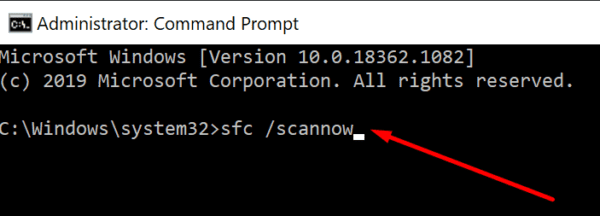
Restart your computer and check for updates again.
Manually Install the Updates
Alternatively, you can install the stubborn updates manually using Microsoft’s Update Catalog website. Close all the unnecessary programs, and open a new browser tab. Then go to Microsoft’s Update Catalog and enter the update’s KB number in the search field. Hit the Download button and check if your computer can install the update.
Conclusion
If error code 0x800f0831 prevents you from installing the latest Windows updates on your computer, restart your router and computer. If the issue persists, manually download the updates from Microsoft’s Update Catalog webpage, and check if your machine can install them. Additionally, run the Update Troubleshooter, and restart the Update Services. If you found other ways to fix Windows Update error 0x800f0831, feel free to share your ideas in the comments below.
How to Fix Windows Update Error 0x800f0831 on Windows 11
On Windows 11, error code 0x800f0831 primarily occurs when installing a cumulative update. This article will discuss the causes of this error and provide you with ways to fix it.
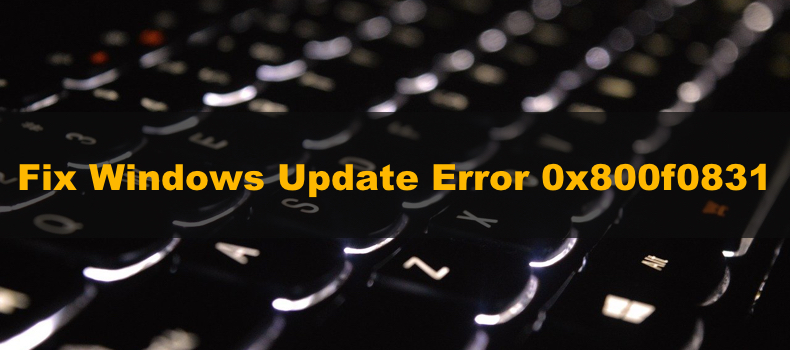
Many Windows 11 users have reported getting this error when installing KB5008212, KB5005190, and KB5005033 updates.
What Causes 0x800f0831?
Our research has revealed that this error can occur for multiple reasons, which are listed below.
- Corrupted Windows Update components. If some core Windows Update components are missing or have been corrupted, the service may fail to install the update.
- Limited disk space. If your system disk has little to no storage left, Windows has no free space to save the update files and trigger the 0x800f0831 error.
- Software conflicts. Sometimes, this error can occur due to the Windows Update service conflicting with a third-party application, such as a VPN app, antivirus, or firewall software. Disabling or removing such software should fix the error. Boot up Windows 11 in Clean Boot Mode and try updating Windows
- A previous update is not installed. In some cases, this error occurs when an update requires the manifest of a prior update package.
- Windows Update is offline. The error can occur if Windows Update servers are down or experience other problems.
Video Instructions on How to Fix Windows Update Error 0x800f0831
Table of Contents:
- Introduction
- Method 1. Run the Windows Update Troubleshooter
- Method 2. Run the Deployment Image & Servicing Management (DISM) Scan
- Method 3. Run the System File Checker (SFC) Scan
- Method 4. Clear Windows Update Cache Folder
- Method 5. Reset Windows Update Components
- Video Instructions on How to Fix Windows Update Error 0x800f0831
Download Computer Malware Repair Tool
It is recommended to run a free scan with Combo Cleaner — a tool to detect viruses and malware on your device. You will need to purchase the full version to remove infections. Free trial available. Combo Cleaner is owned and operated by Rcs Lt, the parent company of PCRisk.com read more.
Method 1. Run the Windows Update Troubleshooter
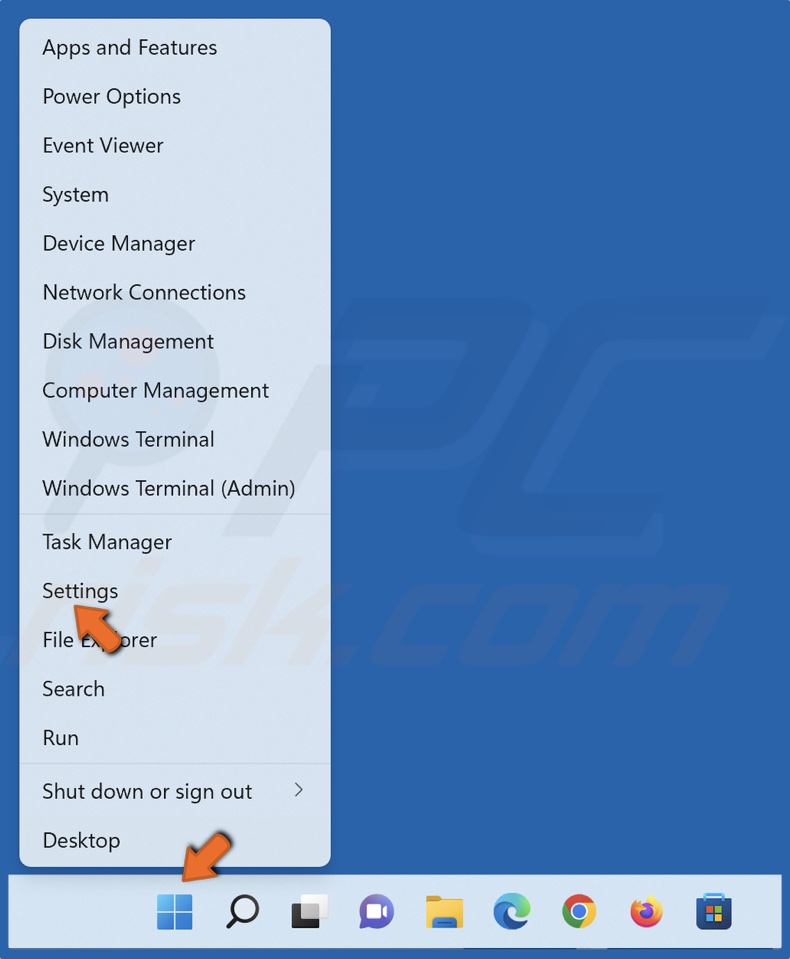
1. Right-click Start and select Settings.
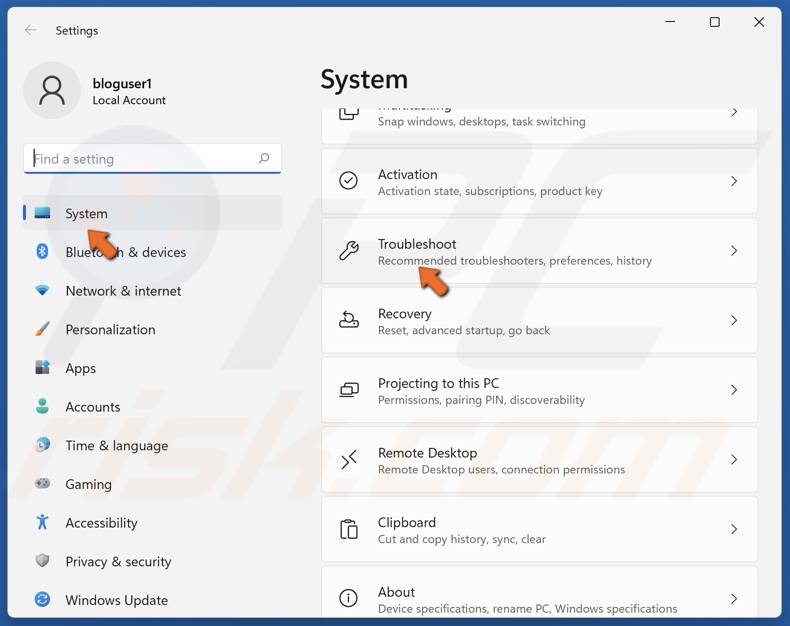
2. In the System panel, scroll down and click Troubleshoot.
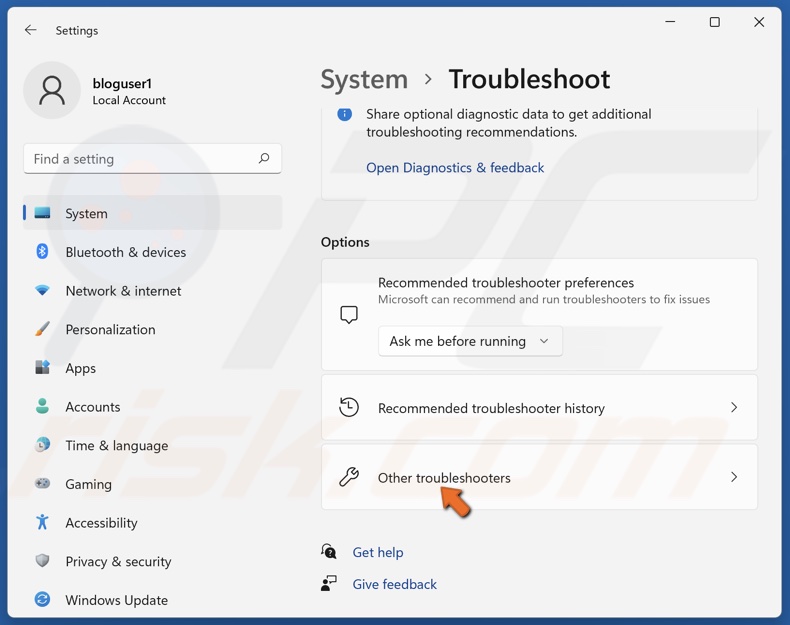
3. Select Other troubleshooters.
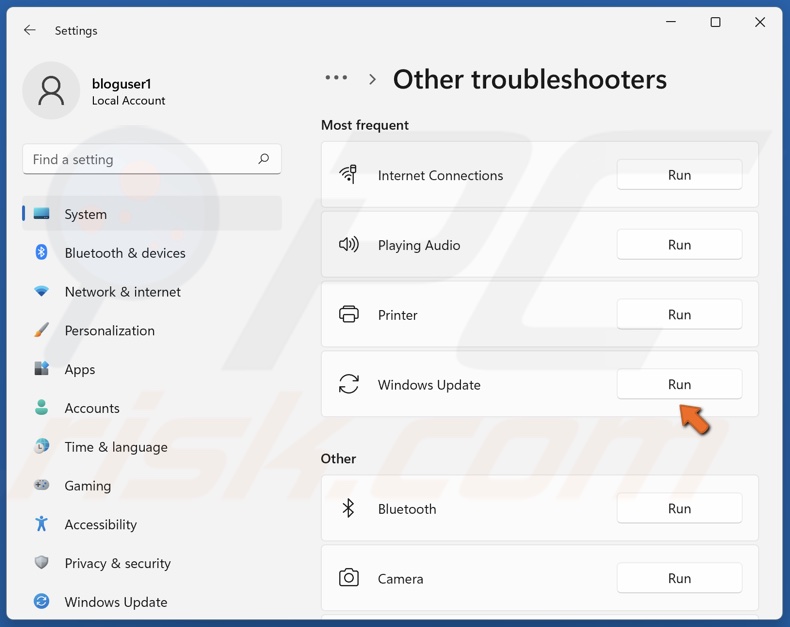
4. Run the Windows Update troubleshooter.
5. Apply the proposed fixes and restart your PC.
[Back to Table of Contents]
Method 2. Run the Deployment Image & Servicing Management (DISM) Scan
1. Hold down Windows+R keys to open Run.
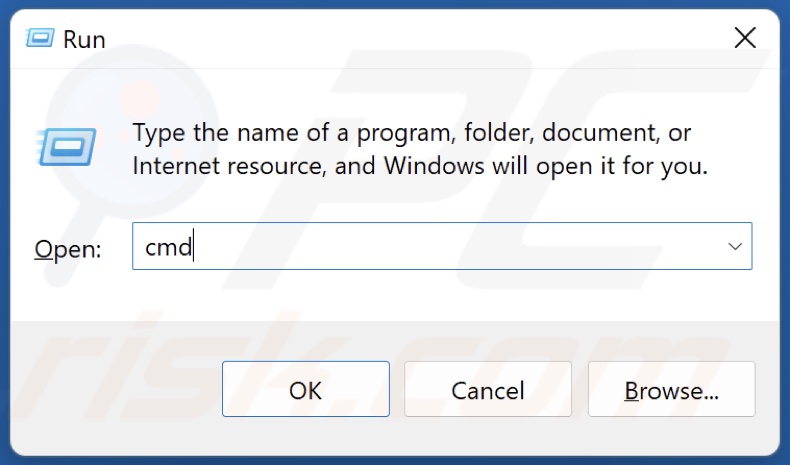
2. In the Run dialog box, type in CMD and hold down Ctrl+Shift+Enter keys to open the Command Prompt as an administrator.
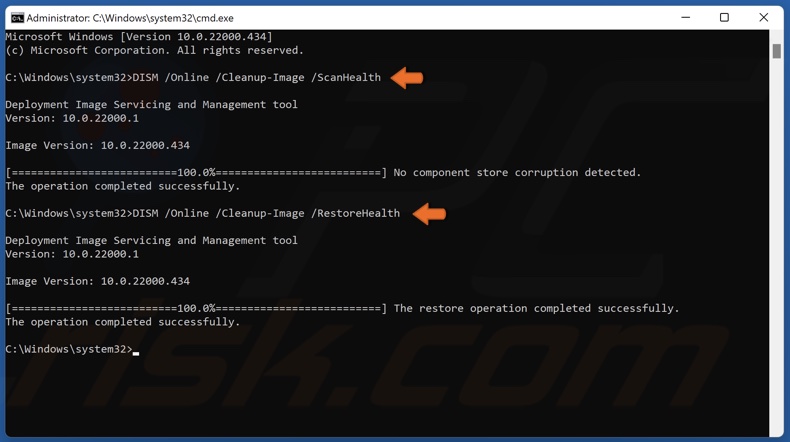
3. In the Comand Prompt window, type in DISM /Online /Cleanup-Image /ScanHealth and press Enter.
4. Type in DISM /Online /Cleanup-Image /RestoreHealth and press Enter.
5. Restart your PC once the scan is complete.
[Back to Table of Contents]
Method 3. Run the System File Checker (SFC) Scan
1. Hold down Windows+R keys to open Run.

2. In the Run dialog box, type in CMD and hold down Ctrl+Shift+Enter keys to open the Command Prompt as an administrator.
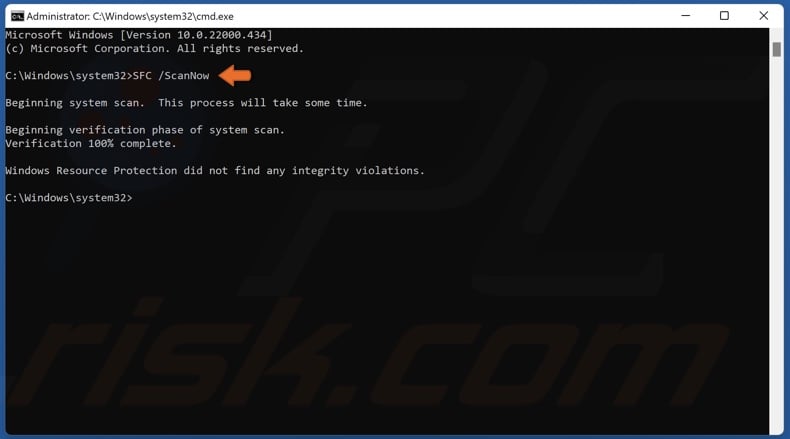
3. In the Command Prompt window, type in SFC /ScanNow and press Enter.
4. Restart your PC once the scan is complete.
[Back to Table of Contents]
Method 4. Clear Windows Update Cache Folder
1. Hold down Windows+R keys to open Run.
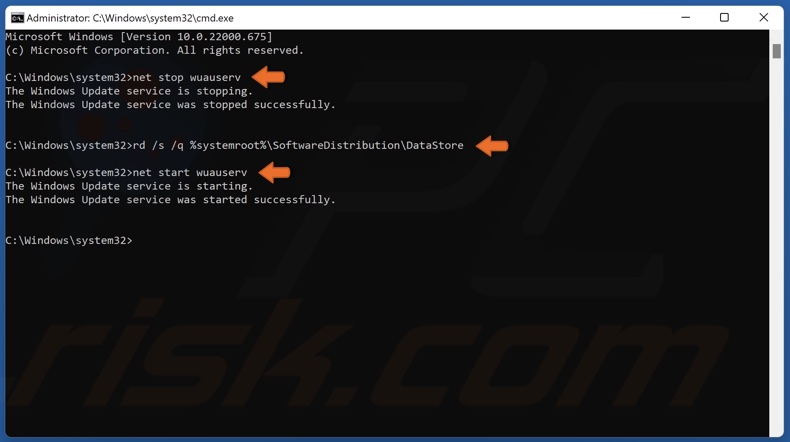
2. In the Run dialog box, type in CMD and hold down Ctrl+Shift+Enter keys to open the Command Prompt as an administrator.
3. In the Command prompt window, type in net stop wuauserv and press the Enter key.
4. Type in rd /s /q %systemroot%\SoftwareDistribution and press Enter.
5. Then, type in net start wuauserv and press Enter.
[Back to Table of Contents]
Method 5. Reset Windows Update Components
1. Hold down Windows+R keys to open Run.

2. In the Run dialog box, type in CMD and hold down Ctrl+Shift+Enter keys to open the Command Prompt as an administrator.
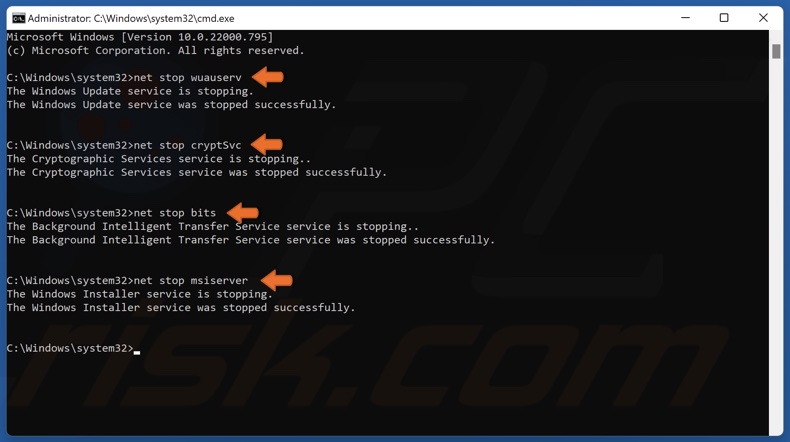
3. In the Command Prompt window, type in the commands below, and press the Enter key after entering each one:
- net stop wuauserv
- net stop cryptSvc
- net stop bits
- net stop msiserver
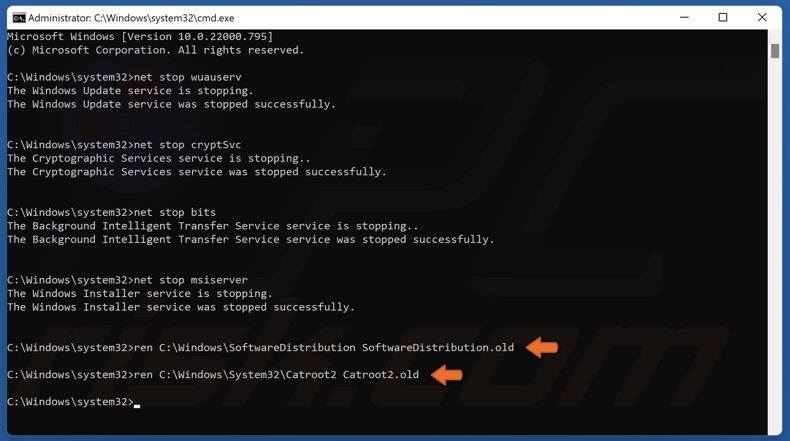
4. Then, type in ren C:\Windows\SoftwareDistribution SoftwareDistribution.old and press Enter.
5. Type in ren C:\Windows\System32\catroot2 Catroot2.old and press Enter.
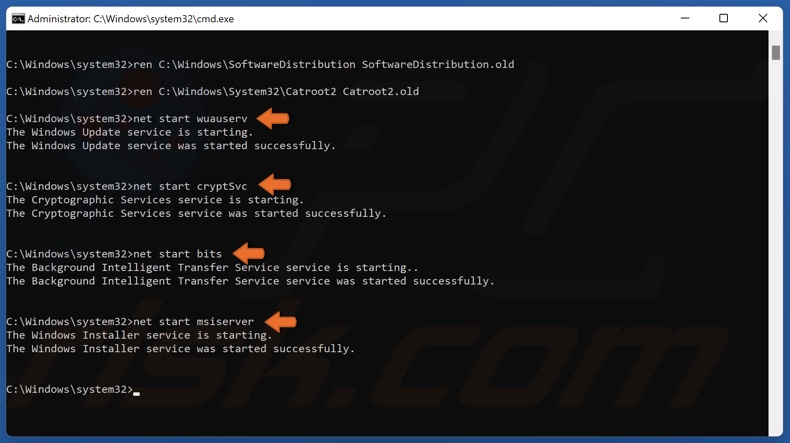
6. Type in the commands below, and press the Enter key after entering each one to restart the stopped services:
- net start wuauserv
- net start cryptSvc
- net start bits
- net start msiserver
7. Try updating Windows.
Did this article help? Let us know by commenting below.
[Back to Top]
The error code 0x800f0831 can usually be traced back to a faulty connection to Windows update servers. Since it’s hard to determine specific causes for the error right away, it helps to have various solutions and see which one works. We explain how error 0x800f0831 can be fixed in Windows 10 and 11 with Windows repair tools, the update troubleshooter and the DISM and SFC tools.
When does the error code 0x800f0831 appear?
Although updates for Windows are usually automatic, you may still sometimes encounter error codes such as 0x80072f8f, 0x800705b4, or 0xc0000005. An error code that you will also encounter frequently during updates is 0x800f0831. The code indicates a problem with the connection to Windows servers, resulting in blocked updates. Since updates are important to keep your Windows system secure, you should address the problem as soon as possible.
Vulnerabilities can occur due to updates and other Windows errors. Protect yourself from cyberthreats with MyDefender from IONOS. It comes with ransomware protection, virus scanning and automatic backups.
Solutions for error 0x800f0831
The following solutions are possible when error 0x800f0831 occurs:
Troubleshoot 0x800f0831 using the Windows update troubleshooter
An obvious and often successful solution is the Windows Troubleshooter tool.
- Access the troubleshooter from the Windows task bar.
- Go to Additional troubleshooters (Windows 10) or to Other troubleshooters (Windows 11).
- Click on Windows Update and on Run to perform troubleshooting for the selected update component.
- Now follow the Windows correction suggestions and restart your PC.
Reset update components
If the troubleshooter does not work, it may help to manually reset the operating system’s update components:
- Open the command prompt with administrator rights by pressing [Ctrl] + [R], typing
cmdand confirming with [Ctrl] + [Shift] + [Enter]. - Disable the Windows Update components one after the other with the following CMD commands. Confirm each command with [Enter]:
net stop wuauserv
net stop cryptSvc
net stop bits
net stop msiserver
ren C:\\Windows\\SoftwareDistribution SoftwareDistribution.old
ren C:\\Windows\\System32\\catroot2 Catroot2.oldbash
- Afterwards, activate each component manually with the following commands:
net start wuauserv
net start cryptSvc
net start bits
net start msiserverbash
- Restart your computer.
Use Windows tools SFC and DISM
Another reason for the 0x800f0831 Windows update error can be damaged Windows system files. Windows provides the SFC (System File Checker) and DISM (Deployment Image Servicing and Management) tools to repair or reset the files.
- Open the command prompt again with [Ctrl] + [R], enter the command
cmdand confirm with [Ctrl] + [Shift] + [Enter]. - Now enter the command
sfc /scannowand press [Enter]. - After the scan is complete, restart your computer.
- If Windows does not find any corrupted system files, start the command prompt again, enter the following commands one after the other and confirm each of them by clicking on [Enter]:
DISM.exe /Online /Cleanup-image /Scanhealth
DISM.exe /Online /Cleanup-image /Checkhealth
DISM.exe /Online /Cleanup-image /Restorehealthbash
- Restart the computer and check if the error is still there.
Install the update manually
If the installation of the update in question still fails, you can download it directly from the Microsoft Update Catalog.
- Visit the Microsoft Update Catalog.
- Search for the KB number to find the correct update. You can determine this by going to Update & Security (Windows 10) or Windows Update (Windows 11) and then Update history. There you will find all successful or failed updates with the corresponding KB number.
- Enter the KB number in the Microsoft Update Catalog in the search field and click Search.
- Click on Download next to the correct update, extract the downloaded file with a double click and select where you want to save it.
- Once the file is unzipped, double-click to install it.
Click here for important legal
disclaimers.
